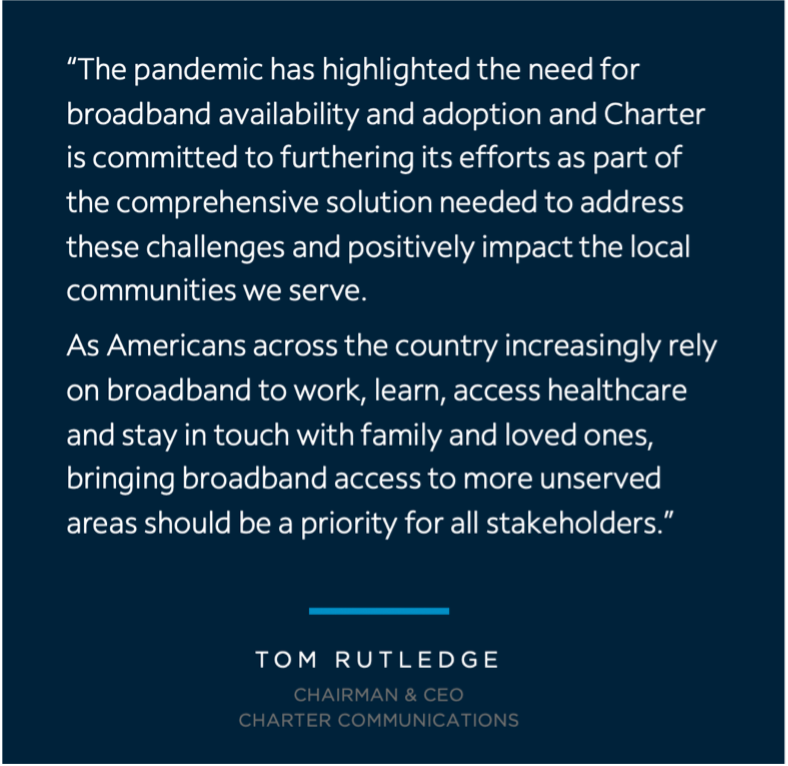Network Investment and Access
A $668 Million Initiative to Expand Broadband Availability to Unserved Wisconsin Homes and Small Businesses
March 3, 2021
Share Article:
Charter has announced plans to deliver gigabit high-speed broadband to approximately 143,000 unserved Wisconsin homes and small businesses, as estimated by the Federal Communications Commission (FCC). As part of this effort, more than $668 million will be invested in Wisconsin, which includes an expected private investment of at least $500 million by Charter and more than $168 million in support won by Charter in the FCC’s Rural Digital Opportunity (RDOF) auction. You can view a map of the Wisconsin expansion here. The effort is part of the company’s recently announced expected investment of approximately $5 billion — offset by $1.2 billion in RDOF support — to expand Charter's network to what the FCC estimates to be more than 1 million homes and small businesses in lower-density, mostly rural communities across 24 states that do not have access to broadband service of at least 25/3 Mbps.
The new initiative is in addition to Charter’s existing network expansion plans and builds upon the company’s long track record of expanding broadband access to unserved and underserved locations.
In a December 2020 report, WMC Foundation’s Future Wisconsin Project identified five challenges to expanding geographic opportunity across Wisconsin and one of the largest was “rural gaps in broadband.” Through this expansion project, Charter is projected to connect nearly 60% of Wisconsin’s RDOF-awarded locations with quality, high-speed broadband, including in three counties not currently served by Charter, which will help to close the gap for many more of Wisconsin’s citizens. The FCC estimates Charter will reach an additional 143,000 homes and small businesses in the state of Wisconsin, making it Charter’s largest RDOF-supported expansion in the country.
Two examples of the transformative effect of Charter’s expansion are found in two very rural northeast Wisconsin counties, Forest and Marinette. Today, about one in three of Forest County’s more than 9,000 residents (35%) and Marinette County’s more than 40,000 residents (32%) lack access to high-speed broadband. As a result of Charter’s investment, an FCC-estimated additional 5,736 homes and small businesses in Forest County and 13,978 in Marinette County will have access to gigabit connectivity from Spectrum Internet®.
Gigabit Broadband with No Data Caps or Modem Fees
The network Charter will build in these mostly rural areas will offer 1 Gbps high-speed broadband access to all newly served customer locations, with starting speeds of 200 Mbps, enabling consumers to engage in remote learning, work, telemedicine and other applications that require high-bandwidth, low-latency connectivity. These newly served customer locations also will benefit from Charter’s high-value Spectrum pricing and packaging structure, including its Spectrum Mobile™, Spectrum TV® and Voice offerings. Charter will continue to apply its customer-friendly policies in newly served regions, including no data caps, modem fees or annual contracts, combined with high-quality service provided by U.S.-based, insourced employees.

The FCC estimates Charter's major infrastructure investment will ultimately reach more than 1 million households and small businesses and will be completed on a rolling basis, with all customer locations expected to be connected within the six-year compliance window. Charter has established an online resource at SpectrumRuralExpansion.com, where consumers can learn more about the RDOF buildout. In the months ahead, the site will include the ability to determine whether specific residential or business locations will be part of the RDOF buildout. And in the future, the site also will allow prospective customers to request email or text message updates from Spectrum as the buildout progresses and more specific information becomes available. As buildouts near completion, Charter will contact customers to provide details about the Spectrum services available and activation time frames.
Timely Execution Depends on Prompt Permitting and Access to Utility Poles
The timely execution and potential reach of the buildout are dependent on several external factors, including the utility pole permitting and “make-ready” processes. With fewer homes and businesses in these areas, broadband providers need to access multiple poles for every new home served, as opposed to multiple homes per pole in higher-density settings. As a result, pole applications, pole replacement rules and their affiliated issue resolution processes are all factors that can have a significant impact on the length of time it takes to complete projects in these rural areas.
Rutledge added, “The stronger collaboration we have among broadband providers, state regulators, pole owners and utility companies, the faster we can connect these communities with high-speed internet services. We look forward to working with local municipalities, electric cooperatives, and investor-owned utilities to ensure that permits are obtained in a timely, fair and cost-effective fashion.”